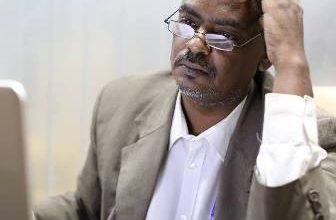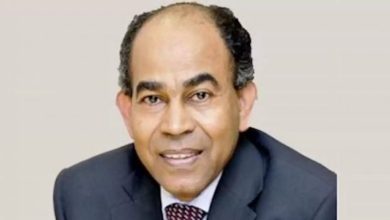The Biggest Failure of the Rapid Support Forces

By: Rakabi Hassan Yaqoub
It is no longer a secret that the “Forces of Freedom and Change” (FFC), led by Abdalla Hamdok, which later transformed into “Taqaddum,” then “Samood,” and most recently into the “Founding Sudan Alliance,” has served as the political wing and civilian sponsor of the Rapid Support Forces (RSF). It has consistently acted as the political ally of the RSF.
This alliance began following the events of October 25, 2021, known as the “Corrective Revolution,” during which then-Prime Minister Abdalla Hamdok was ousted, and his government was dissolved by the Chairman of the Transitional Sovereignty Council, Abdel Fattah al-Burhan. However, Hamdok was reinstated to his position less than a month later, on November 21, 2021, after an agreement was signed to restore the democratic transition and form a new government. However, Hamdok failed to form a new government due to escalating disputes within the FFC, leading to his resignation just 40 days after his reinstatement.
First Failure
This marked the beginning of the consolidation of the alliance between Hamdok’s faction, known as the Central Council, and the RSF, led by Hemetti, who was then Deputy Chairman of the Transitional Sovereignty Council.
The primary motivation for this alliance was the shared ambitions of Hamdok’s group and Hemetti. Hamdok’s group sought to fast-track their rise to power by leveraging the RSF’s military strength against the army, which they believed remained loyal to the Bashir regime and the Islamists. Meanwhile, Hemetti aspired to seize the presidency using his military power, by neutralizing the Sudanese army through the arrest or assassination of al-Burhan, and installing himself as head of state with political backing from Hamdok’s faction.
However, the plan ended in catastrophic failure. The RSF was unable to capture or kill al-Burhan or neutralize the army, while Hamdok’s group failed to provide even minimal political support for the RSF’s coup attempt.
This was the first major failure for the RSF’s political wing and its first ethical collapse, as Hamdok’s group had presented itself as a champion of democracy and civilian rule following the overthrow of Bashir’s regime. Their alliance with the RSF to seize power by force shattered this image.
Second Failure
After the failed coup attempt, the RSF’s political wing had an opportunity to recover by persuading its military ally to withdraw. This chance came three weeks after the failed coup, during the “Jeddah Forum” meetings sponsored by Saudi Arabia and the United States. The Sudanese army and RSF representatives signed an agreement that committed both sides to protecting civilians, including RSF’s withdrawal from occupied civilian properties, and outlined humanitarian commitments and a schedule for further talks.
However, the RSF violated the agreement, expanding its military operations, occupying more civilian properties, and committing human rights violations such as killings, looting, rape, and displacement.
Hamdok’s group could have pressured the RSF leadership to honor the Jeddah agreement, but instead, it justified the RSF’s actions and supported the idea of holding on to what they called “liberated areas.”
This was another political and moral failure for the RSF’s political wing, which dealt a significant blow to its credibility. How could civilian homes and properties be considered “liberated areas”? This marked a turning point in public perception, shifting from viewing the conflict as a power struggle between two generals to seeing it as a war targeting the Sudanese state and its people.
Several factors reinforced this shift, including the involvement of foreign fighters within the RSF and technical military support from regional powers, in addition to the RSF’s harsh treatment of civilians. Hamdok’s group refused to condemn these actions or acknowledge the foreign support for the RSF.
As a result, large segments of Sudanese society rallied behind the army and state institutions. Armed resistance groups in Darfur aligned with the army, and popular armed resistance emerged across Sudan’s states, contributing to significant military advances by the army and setbacks for the RSF.
Third Failure
Another major failure was the RSF’s political wing’s miscalculation in expanding the conflict to central Sudan, including Gezira, Sennar, and parts of White Nile State, where the RSF committed mass atrocities against civilians. This resulted in the highest death toll and largest displacement wave since the war began.
This fueled further public support for the army and popular resistance and triggered international condemnation. Several RSF field commanders were placed on international wanted lists for war crimes. Hamdok’s group, however, denied and downplayed these developments.
The Biggest Failure
Perhaps the most significant failure of the RSF’s political wing was its inconsistent justification for the war. Initially, the RSF claimed it was fighting to restore democracy and civilian rule, then to eliminate Islamists, then to dismantle the post-independence Sudanese state, and finally, to establish a parallel government in RSF-controlled areas, primarily in Darfur — suggesting a push toward secession.
This last goal was the most disastrous failure for both the RSF and its political wing, revealing poor strategic thinking and political miscalculation. Attempting to form a parallel government in Sudan disregarded international law and diplomatic norms, overlooked regional security concerns, and threatened the national security of neighboring Arab and African states.
The reaction from these states was swift and unequivocal, rejecting the idea of a parallel government. This misjudgment demonstrated the RSF’s political wing’s poor grasp of international politics and regional dynamics.
Under international law and the UN Charter, the United Nations cannot recognize a parallel government in a member state with a recognized legitimate government. The same applies to the African Union and the Arab League.
Moreover, neighboring states cannot recognize such a government due to their own internal challenges, which mirror Sudan’s crisis.
This misstep marked the collapse of the political-military alliance between the RSF and Hamdok’s faction, whose ultimate goal had been to seize power through military force.
This political failure coincided with severe military setbacks for the RSF, including the loss of all its occupied territories in Khartoum, Gezira, Sennar, and White Nile, the death of many field commanders, and a decline in manpower as most fighters were foreign mercenaries.
The RSF now holds only parts of Darfur, which are also at risk of being lost in the anticipated battle for El Fasher. The Sudanese army, supported by popular and armed resistance, is well-prepared for this decisive confrontation, while the RSF faces dwindling resources and supply lines.
Given this reality, the RSF faces two grim options: surrender or engage in a final, doomed battle.



